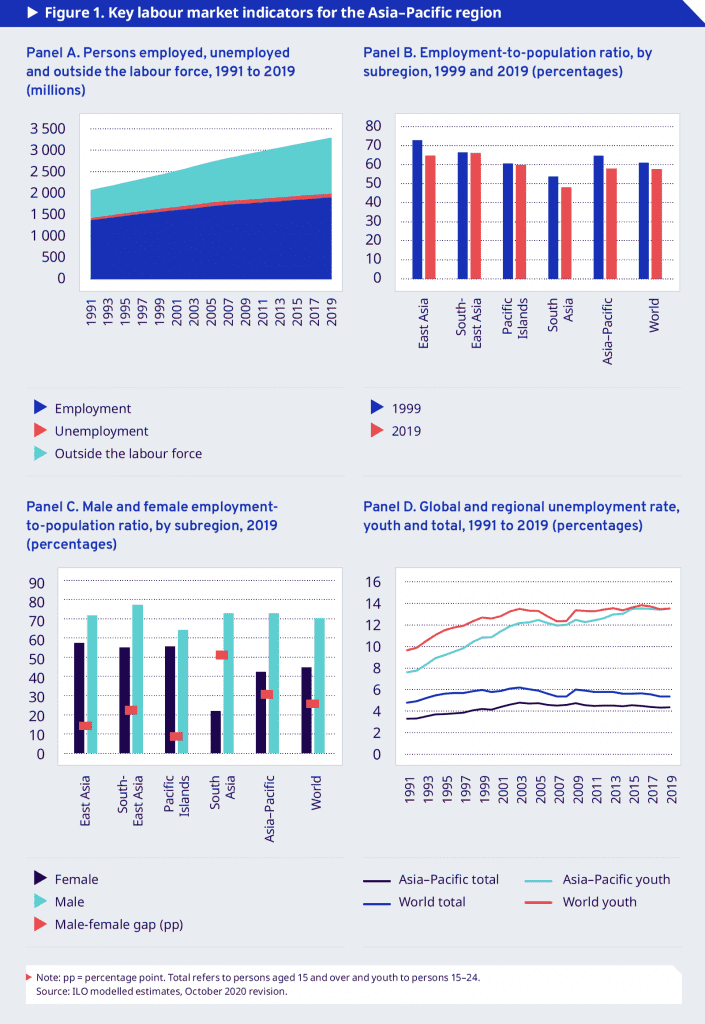APAC workers and enterprises are reeling from the impact of the COVID-19 crisis.
By Marta Chmielowicz
The COVID-19 pandemic and resulting economic crisis has hit economies, enterprises, and workers in the Asia Pacific region hard, according to the International Labour Organization’s 2020 Asia Pacific Employment and Social Outlook report.
While the developing and emerging economies of the region saw rapid growth in the past decade due to a flourishing private sector, foreign investment, and increasing numbers of highly skilled jobs, they also faced significant inequality that has become even more pronounced following the turmoil of 2020. Despite the region’s record of economic growth, 68% of its 1.3 billion workers engage in informal, low skilled, low wage employment. Gender inequality is also a significant issue, especially in South Asia, with women facing lower pay and restricted access to employment, education, and training opportunities.
These inequities were pushed even further as a result of the coronavirus, with many workers forced into poverty due to limited social and employment protections. While the crisis was first felt through a reduction in working hours (approximately 7.3% in the first quarter and 15.2% in the second quarter), it has now resulted in an estimated loss of 81 million jobs. This corresponds to a 4.2% decline in overall employment -a 4.6% decline for women and a 4% decline for men. Young people aged 15 to 24 have been disproportionately affected by working hour and employment losses, with their share in overall employment loss three to 18 times higher than their share in overall employment.
Lost working hours have also contributed to drops in labor income and increases in working poverty. Overall, labor income declined by as much as 9.9% in the first three quarters of 2020, most significantly felt in South Asia (17.6%), South-east Asia and the Pacific (9.5%), and East Asia (7.2%).
The loss of work, wages, and working hours have incurred a massive human cost: 22 million to 25.4 million already-vulnerable people are now facing extreme poverty, living on less than $1.90 per person per day. This increased the poverty rate by 1 percentage point to 5% and brings the total number of working poor to an estimated 94 million to 98 million.
Remarkably, not a single country has been spared the effects of the crisis. Research results show that the hardest-hit countries were those that experienced a collapse in their tourism and manufacturing sectors, including:
- Macau (China) and Maldives had the largest drop in economic growth, with their economies expected to shrink by 52% and 19%, respectively.
- In the Pacific Islands subregion, Fiji and Vanuatu are projected to shrink the most (10% and 8%, respectively).
- Within South-East Asia, Malaysia (6%), Philippines (8%), and Thailand (7%) were among the hardest hit countries.
And the future remains uncertain; while consumption and domestic demand has begun to recover, year-over-year growth rates are lower than they were in 2019. Income and employment loss have resulted in reduced purchasing power and consumer confidence in many countries, with the exception of Australia and Pakistan.
Travel restrictions, quarantine rules, and commercial flight bans have contributed to the collapse of the tourism industry -a key source of employment for many APAC economies. Research shows that tourist arrivals declined by more than 89% in the first eight months of 2020, devastating enterprises and workers in the sector and forcing companies to rely on government support to survive.
Foreign demand has also collapsed, exposing the vulnerability of economies that depend on global production through supply chains. Overall, Australia, India, Japan, Macau (China), Mongolia, and Philippines all experienced double-digit negative growth rates in their exports in the first three quarters of 2020. Manufacturing sectors that produce garments, electronics, and motor vehicles have been affected particularly harshly by the drop in global consumer demand.
With the rise in uncertainty, foreign investment in the APAC region has dried up, with a decline of 34% compared to the previous year. Macau (China), Maldives, Pakistan, Philippines, and Sri Lanka reflected the largest decline in greenfield investment, ranging from 84% to 89%.
Facing these obstacles, governments are under pressure to respond to the needs of workers and enterprises, with advanced economies dictating more funding to their COVID-19 response. Among the 38 economies in the region with comparable data, the median fiscal policy package amounted to 12.4% of GDP, with an average of 24% in high-income economies and 7% in low- and lower-middle-income economies.















